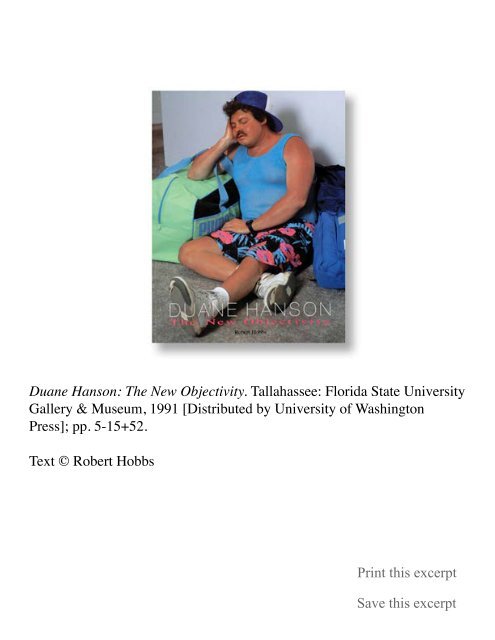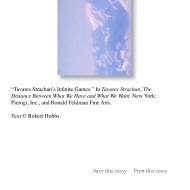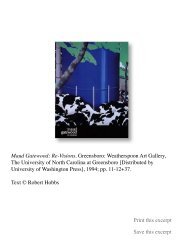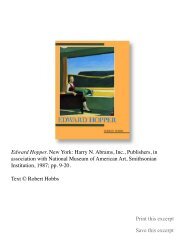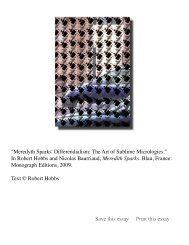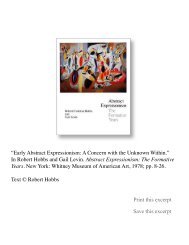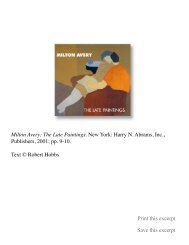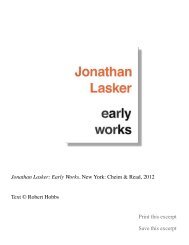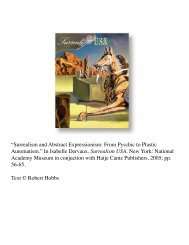Duane Hanson: The New Objectivity. Tallahassee - Robert Hobbs
Duane Hanson: The New Objectivity. Tallahassee - Robert Hobbs
Duane Hanson: The New Objectivity. Tallahassee - Robert Hobbs
Create successful ePaper yourself
Turn your PDF publications into a flip-book with our unique Google optimized e-Paper software.
<strong>Duane</strong> <strong>Hanson</strong>: <strong>The</strong> <strong>New</strong> <strong>Objectivity</strong>. <strong>Tallahassee</strong>: Florida State University<br />
Gallery & Museum, 1991 [Distributed by University of Washington<br />
Press]; pp. 5-15+52.<br />
Text © <strong>Robert</strong> <strong>Hobbs</strong>
DUANE HANSON<br />
<strong>The</strong> <strong>New</strong> <strong>Objectivity</strong><br />
<strong>Robert</strong> <strong>Hobbs</strong><br />
<strong>Duane</strong> <strong>Hanson</strong>, Self-Portrait with<br />
Model, 1979, lifesized polyvinyl,<br />
polychromed in oil, with<br />
accessories. (Photo Credit: D.<br />
James Dee)<br />
It has been common critical and art historical practice to view<br />
<strong>Duane</strong> <strong>Hanson</strong>'s sculpture as part of a reactionary realist wave that<br />
appeared in the late 1960s. Although critic Joseph Masheck in his essay<br />
"Verist Sculpture: <strong>Hanson</strong> and De Andrea" found that "Neo- or <strong>New</strong><br />
Realism touches on Pop concerns but has a blunter, more brutal thrust,"'<br />
he describes this movement as basically diverging from the then-current<br />
dogma concerning abstract avant garde art: "Confidently antiintellectual,<br />
even populist, it sees abstract art and the criticism that<br />
serves it as a sort of .. . folly. Abstraction has been attacked many times<br />
before, but never as comprehensively." Similarly art historian Martin<br />
Bush characterizes <strong>Hanson</strong> as an artist who goes outside the strictures<br />
of the avant garde in order to appeal to life itself:<br />
<strong>Hanson</strong> developed his new approach during the mid-sixties<br />
when he tired of high art and sought a new way for<br />
contemporary artists to capture the public's imagination, just<br />
as artists had done during the Renaissance when crowds<br />
gathered to see a new Michelangelo or Raphael. 2<br />
Although both Masheck and Bush hope to create a proper setting for<br />
<strong>New</strong> Realist art in general and <strong>Duane</strong> <strong>Hanson</strong> in particular, they do not<br />
need to take him outside the realm of the avant garde.<br />
Differing froin Masheck and Bush, Gregory Battcock, who<br />
became known for a series of critical anthologies that include Minimal<br />
An (1968) and Super Realism (1975), suggests that <strong>New</strong> Realism may<br />
not be simply a refutation of avant garde principles but in fact may<br />
continue to explore aspects of it. 3 His firm grounding in Minimal ism<br />
Jed him to posit a basis for <strong>New</strong> Realism in E.C. Goossen's 1968<br />
exhibition at the Museum of Modem Art entitled ''<strong>The</strong> Art of the Real"<br />
which featured Minimalists Carl Andre and Ellsworth Kelly as well as<br />
the Abstract Expressionist Barnett <strong>New</strong>man. Battcock notes that<br />
Goossen's "<strong>The</strong> Art of the Real" had to do with "the verifiable, physical<br />
properties of art objects ... with realistic, as opposed to illusionistic<br />
propenies. " 4 He almost enigmatically suggests that just as Minimal ism<br />
created a "crisis in criticism" by avoiding content so "the new Super<br />
Realist movement will not automatically result in a return to a criticism<br />
of interpretation, although [he admits] such a step within the field of<br />
criticism and aesthetics seems inevitable. " 5 In this passage Battcock<br />
5
first implies a greater critical role for <strong>New</strong> Realism as an inversion<br />
of Minimalism and then partially withdraws the claim that this art is<br />
truly radical by pointing out that it ultimately will result in the old<br />
hegemony of a content based art. Battcock's tentative step toward an<br />
understanding of the radical nature of <strong>New</strong> Realism is significant<br />
because it indicates that the supposed death of the avant garde signified<br />
by this style may actually constitute a misunderstanding of historical<br />
events as well as a failure to comprehend the radical nature of the new<br />
illusionist art.<br />
Sometimes a severe critique of a style can provide important<br />
insights to its special character. Such is the case with Michael Fried's<br />
analysis of Minimalism, which he regards as little more than a surrogate<br />
form of realism, a type of theatrical experience inimical to High<br />
Modernist art. When Fried wrote "Art and Objecthood" which was first<br />
published in 1967 in the June issue of Ariforum and later reprinted in<br />
Battcock's Minimal Art, he was intent on pointing out the inherent<br />
contradictions in Minimalism or "literalist art," as he termed it, which<br />
threatened the High Modernist pretentions of Color Field painting. Fried<br />
championed this latter trend as a qualitative endeavor in which the<br />
essence of art is conceived as a virtual surface so that "at every moment<br />
the work itself is wholly manifest. " 6 In his effort to denigrate<br />
Minimalism as mere theater, Fried pointed out that the viewing of this<br />
art involves a period of duration during which the observer becomes<br />
part of an interactive process in which the art, a mere stage prop,<br />
becomes a surrogate being. "I am suggesting, then," Fried wrote, "that<br />
the kind of latent or hidden naturalism, indeed anthropomorphism, lies<br />
at the core of literalist theory and practice. " 7 He regards this interactive<br />
process as a theatrical effect and refers to the stage presence of the<br />
literalist objects created by the Minimalists. <strong>The</strong> space created is the<br />
actual space of everyday life and not the virtual space of the High<br />
Modernist painting he wished to uphold. He regarded Minimalist art as<br />
little more than a vanguard aberration because it did not attain the<br />
virtual, idealistic, almost sacred space of High Modernist painting and<br />
instead accorded art no more privileged a status than an inert object.<br />
While High Modernism is an elitist vanguard, Minimalism is a<br />
democratic one in its disregard of art's privileged position. Although<br />
Fried does not pursue in this essay the anthropomorphic aspect of<br />
Minimalism beyond indicating his belief that it is a regressive tendency<br />
that Minimalists have not yet expunged from their work, his critique<br />
has important ramifications for understanding the actual space of some<br />
<strong>New</strong> Realist sculpture and in particular <strong>Duane</strong> <strong>Hanson</strong>'s art which is<br />
involved with a stage presence and actual space similar to Minimalist<br />
art. <strong>The</strong> only Realist who has heretofore been associated with<br />
COLORPLATES ARE PRESENTED<br />
IN CHRONOLOGICAL SEQUENCE.<br />
<strong>Duane</strong> <strong>Hanson</strong>, Hard Hat, 1970,<br />
lifesized polyester resin and<br />
fiberglass, polychromed in oil,<br />
with accessories. Collection:<br />
Sydney and Frances Lewis,<br />
Virginia Museum ot Fine Arts.
Minimalism is Chuck Close who makes portraits of enlarged snapshots,<br />
and not of people per se, and emphasizes the actual space of the<br />
photograph over the virtual presence of Modernist painting. Similar to<br />
the Minimalists, Close perpetuates a residual anthropomorphism.<br />
While Fried thought the Minimalists' relationship to human<br />
beings was a regressive tendency that caused their art to be no more<br />
than statuary, residual anthropomorphism was apparently not disdained<br />
by Minimalists Carl Andre, Donald Judd, <strong>Robert</strong> Morris, and Tony<br />
Smith who were all concerned with the scale of the people looking at<br />
their work. Morris and Smith even made the quality of the<br />
anthropomorphic other a modus operandi of the human scale and of the<br />
hollow forms making up Colwnn and Die respectively. 8 When Column<br />
was first shown, it was actually a stage prop. Morris stood upright in<br />
it for 3 minutes and 30 seconds before tipping it on its side where he<br />
remained in it for another 3 minutes and 30 seconds before the curtain<br />
came down on this brief performance. Tony Smith's Die, a six foot cube,<br />
confronts viewers with a hollow box of human height that is slightly<br />
wider than a figure with outstretched arms. It effectively obstructs one's<br />
view over it, and its hollowness makes it appear a mysterious other, a<br />
repository of the unknown.<br />
Also included in Battcock's anthology Minima/ism is Barbara<br />
Rose's article "ABC Art" which was originally published in 1965 in Art<br />
in America. This essay serves more than any other piece to canonize<br />
Minimalism. An analysis of its approach to Minimalism is an important<br />
and necessary step in our discussion of the connections between<br />
Minimalism and the <strong>New</strong> Realism of <strong>Duane</strong> <strong>Hanson</strong>. Since Barbara<br />
Rose was then married to the painter Frank Stella who was himself<br />
sympathetic to the Minimalist sensibility and friendly with important<br />
sculptors working in this vein, including Carl Andre and <strong>Robert</strong> Morris,<br />
she was in an excellent position to describe this style from the artists'<br />
point of view. Minimal ism, which refers primarily to abstract sculpture<br />
made after 1960, is notable for its emphasis on geometry, a lack of<br />
detail, an industrial look, and blurred distinctions between art and nonart.<br />
Since Rose was privy to studio conversations, she was familiar with<br />
the rhetoric of the Minimalists, particularly their sincere interest in<br />
considering the traditional pejoratives blank, vacant, hollow, boring,<br />
and inert as approbations. At the beginning of her essay, she noted:<br />
Today we are feeling the impact of their [Kasimir Malevich's<br />
and Marcel Duchamp's] decisions in an art whose blank,<br />
neutral, mechanical impersonality contrasts so violently with<br />
the romantic, biographical Abstract Expressionist style which<br />
preceded it that spectators are chilled by its apparent lack of<br />
feeling or content. 9<br />
<strong>Duane</strong> <strong>Hanson</strong>, Young Shoppe~<br />
1973, lifesized polyester and<br />
fiberglass, polychromed in oil, with<br />
accessories. Private Collection.
10<br />
<strong>Duane</strong> <strong>Hanson</strong>, Photographer, 1978,<br />
lifesized polyvinyl, polychromed in<br />
oil, with accessories. Collection:<br />
Jesse N. Karp, <strong>New</strong> York.<br />
<strong>The</strong> Minimalists embraced a style of "blank, neutral, mechanical<br />
impersonality" because it challenged the traditional limits of sculpture<br />
by making it resemble inert objects.<br />
In "ABC Art" Rose draws an intriguing parallel between<br />
Minimalism and the French objective <strong>New</strong> Novel, a parallel that will<br />
have an important bearing on our understanding of <strong>Hanson</strong>'s sources,<br />
as we shall see later in the essay. As an epigram to the section entitled<br />
''Art as Concrete Object," she includes Alain Robbe-Grillet's Zen-like<br />
testimony on the primacy of being:<br />
Now the world is neither meaningful nor absurd. It simply is.<br />
In place of this universe of "meanings" (psychological, social,<br />
functional), one should try to construct a more solid, more<br />
immediate world. So that first of all it will be through their<br />
presence that objects and gestures will impose themselves, and<br />
so that this presence continues thereafter to dominate, beyond<br />
any theory of explication that might attempt to enclose them<br />
in any sort of sentimental, sociological, Freudian,<br />
metaphysical, or any other system of reference. 10<br />
This passage was taken from Robbe-Grillet's theoretical essay "Une<br />
voie pour le roman futur" ( 1956) that was translated into English for<br />
publication in the third issue of <strong>The</strong> Evergreen Review (1957). 11 Later it<br />
was included in the Grove Press anthology of Robbe-Grillet's writings<br />
entitled For a <strong>New</strong> Novel: Essays on Fiction ( 1965). ' 2 Robbe-Grillet's essay<br />
was thus available in English to American avant garde audiences who<br />
read <strong>The</strong> Evergreen Review and its affiliated Grove Press publications. In<br />
the late fifties Grove Press made a concerted effort to publish English<br />
translations of Robbe-Grillet's novels. <strong>The</strong> following titles and dates for<br />
the French publications followed by the Grove Press editions give an<br />
idea of this author's popularity in the United States: <strong>The</strong> Voyeur (French<br />
edition 1955, English edition 1958), Jealousy (French 1957, English<br />
1959), In the Labyrinth (French 1959, English 1960), and Last lear at<br />
Marienbad (French 1961, English 1962). Because of the success of these<br />
books, <strong>The</strong> Erasers was also published in a Grove Edition but it was<br />
published in 1964, eleven years after it first appeared in French. Not<br />
only were these books published in cloth editions but they were also<br />
available in paperback, so they evidently appealed to a large audience.<br />
Considering the availability in English of Robbe-Grillet's books, it is<br />
surprising that Barbara Rose undertook her own translation of the<br />
passage cited above and made the effort to point out that even though<br />
the author's ideas formed intriguing parallels to Minimalism, they were<br />
not sources for this style.<br />
"Curiously," Rose comments, "it is perhaps in the theory of the<br />
French objective novel that one most closely approaches the attitude of<br />
<strong>Duane</strong> <strong>Hanson</strong>, Man on Bench,<br />
1977-78, lifesized polyvinyl,<br />
polychromed in oil, with<br />
accessories. Collection: Richard<br />
and Gloria Anderson, Kansas.
many of the artists I've been talking about. I am convinced that this is<br />
sheer coincidence, since I have no reason to believe there has been any<br />
specific point of contact." 13 In place of Robbe-Grillet, Rose suggests<br />
Ludwig Josef Johann Wittenstein because she knew that a number of<br />
Minimalists had actually read his work.'• In 1965 it may have seemed<br />
that the Minimalists would have had to have read Robbe-Grillet in order<br />
to have been familiar with ideas historically ascribed to him. Our<br />
present understanding of the then-important intellectual currents would<br />
cause us to be surprised if these artists had not heard of Robbe-Grillet<br />
and his ideas, particularly when one considers the relatively small size<br />
of the <strong>New</strong> York avant garde at that time and the intense interests<br />
Minimalists had in new ideas. One might suspect that even in the 1960s<br />
American artists were careful to avoid admitting, at least publicly,<br />
French ideas formative to their work. Since <strong>New</strong> York replaced Paris<br />
as the international capital of art after World War II, there was evidently<br />
a need in the 1960s to separate American art from recent French<br />
developments: therefore American art might have sources in<br />
Wittenstein, but France was still too close and too much a threat to <strong>New</strong><br />
York's newly established hegemony.<br />
To comprehend the wide-spread dissemination of Robbe-Grillet's<br />
ideas that affected Minimalism, and later <strong>New</strong> Realism, and Photo<br />
Realism, one need only consider Susan Sontag's famous article of 1964<br />
"Against Interpretation" which makes overt references to Robbe-Grillet<br />
as well as to a number of other writers, critics, filmmakers, and<br />
painters.' 5 In addition, Sontag's essay relies on Robbe-Grillet's basic<br />
outlook. In this essay Sontag makes the point that interpretation robs<br />
art of its immediacy and power. Her following statement is a pendant<br />
to the Robbe-Grillet passage that Barbara Rose cited in '~BC Art."<br />
In most modern instances, interpretation amounts to the<br />
philistine refusal to leave the work alone. Real art has the<br />
capacity to make us nervous. By reducing the work of art to<br />
the content and then interpreting that, one tames the work of<br />
art. Interpretation makes art manageable, comfortable.'•<br />
At the end of the essay, she - like Robbe-Grillet - opts for a Zen<br />
appreciation of the here and now:<br />
<strong>The</strong> aim of all commentary on art now should be to make<br />
works of art - and, by analogy, our own experience - more,<br />
rather than less, real to us. <strong>The</strong> function of criticism should be<br />
to show how it is what it is, even that it is what it is, rather than<br />
to show what it means. 17<br />
Although Minimalism is an art that attempts to avoid the limitations<br />
of meaning, Sontag does not mention this style in her essay: her<br />
interests in the article are confined primarily to film and literature. But<br />
<strong>Duane</strong> <strong>Hanson</strong>, Dockman, 1979,<br />
lifesized polyvinyl, polychromed in<br />
oil, with accessories. Collection:<br />
Yellow Freight System Inc. (Photo<br />
Credit: Murray Spitzer)
even though she does not refer to Minimalism, her emphasis on Robbe<br />
Grillet's ideas that so clearly anticipate Minimalism's desire to avoid<br />
content and interpretation indicates a broad-based sensibility at work in<br />
the 1960s, a sensibility that is present in the art that some <strong>New</strong> Realists<br />
and Photo-Realists began to create later in the decade. Sontag's essay<br />
testifies to Robbe-Grillet's importance in the United States and<br />
represents one way that his ideas were being disseminated.<br />
<strong>The</strong> purpose of the discussion has thus far been to question the<br />
supposed reactionary nature of <strong>New</strong> Realist art in order to suggest that<br />
it has affinities with Minimalism, to indicate that Minimalism might<br />
have had a source in the objective new novel outlined by Robbe-Grillet,<br />
and to point to the general interest in objectivity and realism that<br />
developed out of Robbe-Grillet's writing and that was evident first in<br />
Minimalist art and in Sontag's seminal essay ''Against Interpretation,"<br />
and later became important in <strong>New</strong> Realist art. Throughout this<br />
discussion I have implied that the emphasis on the here and now may<br />
have developed out of Zen, which became popular in this country in<br />
the 1950s as an indirect result of contacts with Japan that developed<br />
after World War II. With the emphasis on enlightenment achieved<br />
through an acceptance of prosaics, Zen helped to initiate in the United<br />
States a reappraisal of reality that affected the Minimalists in their<br />
choice of industrial materials and the <strong>New</strong> Realists in their use of<br />
photographs and life castings. Zen, together with the French objective<br />
novel and the post-war explosion of American industry and<br />
consumerism, can be considered an important source for Minimalism<br />
and <strong>New</strong> Realism. <strong>The</strong>se factors formed an intellectual, aesthetic, and<br />
socio-economic backdrop for <strong>Duane</strong> <strong>Hanson</strong>'s sculpture.<br />
In his sculpture <strong>Hanson</strong> moved rapidly in the late 1960s from an<br />
art of social conscience to gently satirical works extolling the mundane<br />
and everyday before he began appreciating realism for its own sake. In<br />
his art he blurred differences between art and life in a manner akin to<br />
the Minimalists. Although it would be wonderful to say that <strong>Hanson</strong><br />
transformed Minimalism into its diametrical opposite <strong>New</strong> Realism,<br />
such an inversion is too simple. It is also inconsistent with actual<br />
events, with the artist's aspirations, and with his allegiances to the<br />
perceived opposing camp. In spite of his quest for a mimetic fidelity<br />
that ultimately results in tough-minded objectivity, <strong>Hanson</strong> has always<br />
been uncomfortable with the distance that the Minimalists among others<br />
maintain with their work. Even though he may strive in his mature<br />
works for objectivity, he is passionate about his subject. One might say<br />
that his passion in works beginning in 1973, however, is limited to his<br />
choice of subject matter. Once a subject is chosen, he becomes a<br />
detached yet intense observer.<br />
<strong>Duane</strong> <strong>Hanson</strong>, Fundraiser. 1980,<br />
lifesized polyvinyl, polychromed in<br />
oil, with accessories. Collection:<br />
Paul and Camille Oliver-Hoffman.<br />
(Photo Credit: Murray Spitzer)
N 0 T E s<br />
'Joseph Masheck, "Verist Sculpture," Art in America 60 (November<br />
1972), 90.<br />
2<br />
Martin H. Bush, <strong>Duane</strong> <strong>Hanson</strong> (Wichita: Edwin A. Ulrich Museum of<br />
Art, Wichita State University, October 6, 1976-November 11, 1977), 10-11. This<br />
catalogue for <strong>Hanson</strong>'s first retrospective exhibition was shown at University<br />
of Nebraska Art Galleries, Des Moines Art Center, University Art Museum/<br />
Berkeley, Portland Art Museum, William Rockhill Nelson Gallery and Atkins<br />
Museum of Fine Arts, Colorado Springs Fine Arts Center, and Virginia Museum<br />
of Fine Arts. Although Bush segregates <strong>Hanson</strong> from vanguard art, he provides<br />
an important first thorough assessment of the artist's work and includes a<br />
number of the artist's statements taken from his own interviews.<br />
'Gregory Battcock (ed.), Super Realism: A Critical Anlhology (<strong>New</strong> York:<br />
E.P. Dutton & Co., Inc., 1975), xxii.<br />
4<br />
Ibid.<br />
5<br />
Jbid.<br />
6<br />
Battcock (ed.) MinimLll An: A Critical Anlhology (<strong>New</strong> York: E.P. Dutton<br />
& Co., Inc., 1968), 145.<br />
'Ibid., 129.<br />
"Tony Smith's Die was created in 1962 in steel. It belongs to the<br />
artist's estate.<br />
9<br />
Minimi1l An, 274-275.<br />
'"Ibid., 291-292.<br />
"Entitled ''A Fresh Start for Fiction" the essay has been republished in<br />
Evergreen Review Reader: A Ten-Year Anthology, edited by Barney Rossat<br />
(Secaucus, N.J.: Castle Books, 1968), 57-59. <strong>The</strong> text was translated by<br />
Richard Howard.<br />
12<br />
For a <strong>New</strong> Novel was translated by Richard Howard.<br />
"Minimal An, 292.<br />
14Jbid.<br />
' 5 "Against Interpretation" was originally published in <strong>The</strong> Evergreen<br />
Review in 1964. See A Susan Sontag Reader (<strong>New</strong> York: Vintage Books,<br />
1983), 95-104.<br />
16<br />
Ibid., 99.<br />
"Ibid., 104.<br />
18<br />
Kirk Varnedoe, <strong>Duane</strong> <strong>Hanson</strong> (<strong>New</strong> York: Harry N. Abrams, Inc.,<br />
Publishers, 1985), 31.<br />
••Evergreen Review Reader, 59.<br />
2<br />
"<strong>The</strong> terms virtual versus actual space are taken from Michael Fried's<br />
''Art and Objecthood" discussed earlier in this essay.<br />
21<br />
Quoted in Fried's ''Art and Objecthood," Minimal An, 125.<br />
22<br />
Bush, Sculptures by <strong>Duane</strong> <strong>Hanson</strong> (Wichita: Edwin A. Ulrich Museum<br />
of Art, Wichita State University, 1985), 15.


